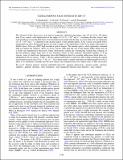ULTRALUMINOUS X-RAY SOURCES IN ARP 147
Author(s)
Pooley, D.; Steinhorn, B.; Rappaport, Saul A; Levine, Alan M
DownloadRappaport-2010-ULTRALUMINOUS X-RAY.pdf (1.088Mb)
PUBLISHER_POLICY
Publisher Policy
Article is made available in accordance with the publisher's policy and may be subject to US copyright law. Please refer to the publisher's site for terms of use.
Terms of use
Metadata
Show full item recordAbstract
The Chandra X-Ray Observatory was used to image the collisional ring galaxy Arp 147 for 42 ks. We detect nine X-ray sources with luminosities in the range of (1.4-7) × 10[superscript 39] erg s[superscript –1] (assuming that the sources emit isotropically) in or near the blue knots of star formation associated with the ring. A source with an X-ray luminosity of 1.4 × 10[superscript 40] erg s[superscript –1] is detected in the nuclear region of the intruder galaxy. X-ray sources associated with a foreground star and a background quasar are used to improve the registration of the X-ray image with respect to Hubble Space Telescope (HST) high-resolution optical images. The intruder galaxy, which apparently contained little gas before the collision, shows no X-ray sources other than the one in the nuclear bulge which may be a poorly fed supermassive black hole. These observations confirm the conventional wisdom that collisions of gas-rich galaxies trigger large rates of star formation which, in turn, generate substantial numbers of X-ray sources, some of which have luminosities above the Eddington limit for accreting stellar-mass black holes (i.e., ultraluminous X-ray sources, "ULXs"). We also utilize archival Spitzer and Galex data to help constrain the current star formation rate in Arp 147 to ~7 M [subscript ☉] yr[superscript –1]. All of these results, coupled with binary evolution models for ULXs, allow us to tentatively conclude that the most intense star formation may have ended some 15 Myr in the past.
Date issued
2010-09Department
Massachusetts Institute of Technology. Department of Physics; MIT Kavli Institute for Astrophysics and Space ResearchJournal
Astrophysical Journal
Publisher
IOP Publishing
Citation
Rappaport, S., A. Levine, D. Pooley, and B. Steinhorn. “ULTRALUMINOUS X-RAY SOURCES IN ARP 147.” The Astrophysical Journal 721, no. 2 (September 9, 2010): 1348–1355. © 2010 The American Astronomical Society
Version: Final published version
ISSN
0004-637X
1538-4357